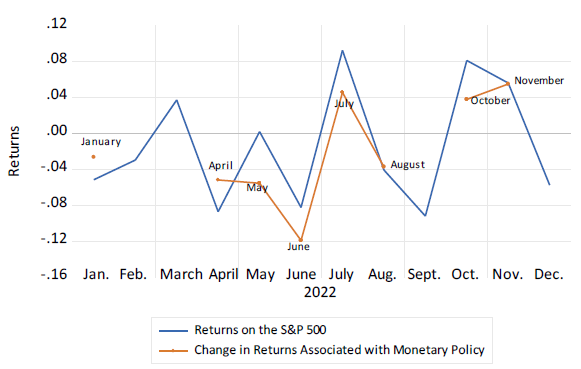| Author Name | Willem THORBECKE (Senior Fellow, RIETI) |
|---|---|
| Research Project | Economic Shocks, the Japanese and World Economies, and Possible Policy Responses |
| Download / Links |
This Non Technical Summary does not constitute part of the above-captioned Discussion Paper but has been prepared for the purpose of providing a bold outline of the paper, based on findings from the analysis for the paper and focusing primarily on their implications for policy. For details of the analysis, read the captioned Discussion Paper. Views expressed in this Non Technical Summary are solely those of the individual author(s), and do not necessarily represent the views of the Research Institute of Economy, Trade and Industry (RIETI).
News about COVID-19, inflation, and monetary policy has buffeted the U.S. economy since 2020. As the pandemic emerged, the Federal Reserve lowered its target for the federal funds rate by 150 basis points in March 2020. The year-on-year change in the U.S. consumer price index (CPI) then rose from 1.5% in March 2020 to 8.6% in June 2022. The Fed raised its funds rate target by 500 basis points in 2022 and 2023. This paper investigates how monetary policy news has impacted the stock market since the coronavirus crisis began.
The Fed responded to the pandemic not only by lowering the funds rate but also by providing forward guidance that interest rates would remain low, purchasing Treasury and mortgage-backed securities, lending to Treasury security primary dealers, backstopping money market funds, and encouraging bank lending and credit extension. The government provided three rounds of stimulus checks. These policies increased demand while negative shocks associated with the pandemic, value chain disruptions, and the Russia-Ukraine War restricted supply.
This combination contributed to inflation that proved higher and more persistent than the Fed expected. At the end of 2020 the median forecast of Federal Reserve Board members and Federal Reserve Bank presidents was that the personal consumption expenditures (PCE) price index would grow by 1.8% between the 2020Q4 and 2021Q4. It actually grew by 5.7%. At the end of 2021 the median forecast was for the PCE index to grow by 2.6% between 2021Q4 and 2022Q4. It again grew by 5.7%. In November 2021 Fed Chair Jerome Powell stopped calling inflation transitory and in 2022 the Fed began aggressively raising the funds rate.
This paper investigates how monetary policy has impacted financial markets since the pandemic began. To do this it first estimates the exposures (betas) of 53 assets to monetary policy over the 1988 to 2019 period. It then uses these monetary policy betas to examine how investors responded to news about monetary policy beginning in 2020. If investors believed that monetary policy would become contractionary, they would sell assets that are harmed by tighter policy and purchase assets that benefit from tighter policy. This would lower the prices of assets that are harmed by contractionary monetary policy and raise the prices of assets that benefit.
As Figure 1 shows, the results indicate that changing perceptions about monetary policy caused large swings in U.S. equity prices in 2022. The paper also reports frequent changes in stock prices at the daily level in 2022. As the Fed pursued drastic tightening it thus sewed confusion and multiplied volatility in the U.S. stock market, one of the world’s most important financial markets.
Eggertsson and Kohn (2023) observed that, as inflation rose after the pandemic, many were uncertain of the Fed’s intentions. Dietrich et al. (2022) found that better communication by the central bank to the public could have mitigated uncertainty. Arteta et al. (2022) reported that changing perceptions about the Fed’s preferences towards inflation explained much of the movement in asset prices in 2022 and concluded that proper communication that clarified the Fed’s reaction function could have reduced adverse spillovers. Improved communication could thus have helped to attenuate the wild swings in stock prices that arose because of uncertainty about monetary policy.
The Fed should have pursued improved communication in two areas. First, it should have clarified the economic model that Fed Chairman Powell was using when deciding whether inflation was transitory or lasting. Second, it should have specified ahead of time how the Fed would react if it decided that inflation was not transitory but lasting. Understanding these two issues would have reduced the uncertainty about monetary policy that was pervasive after the pandemic. The Bank of Japan and other central banks should similarly pursue clear communications with the public.

- Reference(s)
-
- Arteta, C., S. Kamin, and F. U. Ruch. (2022). “How Do Rising U.S. Interest Rates Affect Emerging and Developing Economies? It Depends.” Policy Research Working Paper 10258, World Bank.
- Dietrich, A., K. Kuester, G. Müller, and R. Schoenle. (2022). “News and Uncertainty about COVID-19: Survey Evidence and Short-run Economic Impact.” Journal of Monetary Economics 129 (July): S35-S51.
- Eggertsson, G., D. Kohn. (2023). “The Inflation Surge of the 2020s: The Role of Monetary Policy.” Presentation at Hutchins Center, Brookings Institution, 23 May. Available at: https://www.brookings.edu/wp-content/uploads/2023/04/Eggertsson-Kohn-conference-draft_5.23.23.pdf

